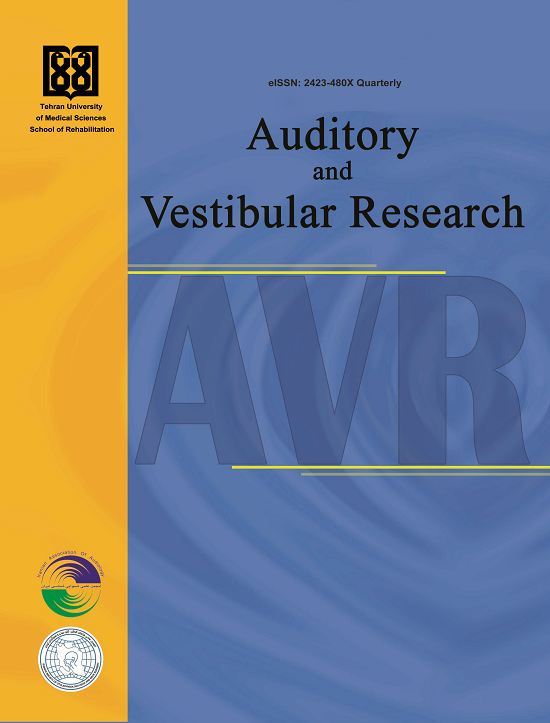Hyperspectral Imaging Tympanoscope: System Development and preliminary Study for Assessment of Its Potential as a Diagnostic Tool
Abstract
Background and Aim: Accurate diagnosis of middle ear effusion (MEE) remains one of the most challenging tasks in the medical field due to the lack of reliable diagnostic tools available to physicians and audiologists. This study aimed to design and develop a hyperspectral imaging tympanoscope for diagnosing MEE as the first phase, focusing on system design and preliminary evaluation in a small sample.
Methods: The tympanoscope system was constructed using an ear endoscope, lens, camera, and near-infrared wavelength, and its performance was evaluated with a middle ear-mimicking phantom. Additionally, a preliminary study was conducted on middle ear images from ten children—five healthy and five diagnosed with MEE.
Results: Results from the phantom experiments demonstrated that the Weber contrast difference between phantoms with and without fluid in visible otoscopy and hyperspectral tympanoscopy was 0.16 and 0.49, respectively. As a result, in hyperspectral tympanoscopy, the contrast difference between fluid presence and absence was nearly tripled. Furthermore, in the preliminary human study, significant difference was found in Weber contrast between healthy children and those with MEE (p<0.001), confirming higher contrast in the MEE group.
Conclusion: The hyperspectral imaging tympanoscope could quantitatively distinguish between the presence or absence of fluid in the middle ear and the developed system has potential as a diagnostic and monitoring tool for middle ear effusion.
2. Qureishi A, Lee Y, Belfield K, Birchall JP, Daniel M. Update on otitis media - prevention and treatment. Infect Drug Resist. 2014;7:15-24. [DOI:10.2147/IDR.S39637]
3. Sundvall PD, Papachristodoulou CE, Nordeman L. Diagnostic methods for acute otitis media in 1 to 12 year old children: a cross sectional study in primary health care. BMC Fam Pract. 2019;20(1):127. [DOI:10.1186/s12875-019-1018-4]
4. Abbott P, Rosenkranz S, Hu W, Gunasekera H, Reath J. The effect and acceptability of tympanometry and pneumatic otoscopy in general practitioner diagnosis and management of childhood ear disease. BMC Fam Pract. 2014;15:181. [DOI:10.1186/s12875-014-0181-x]
5. Carr JA, Valdez TA, Bruns OT, Bawendi MG. Using the shortwave infrared to image middle ear pathologies. Proc Natl Acad Sci U S A. 2016;113(36):9989-94. [DOI:10.1073/pnas.1610529113]
6. Valdez TA, Pandey R, Spegazzini N, Longo K, Roehm C, Dasari RR, Barman I. Multiwavelength fluorescence otoscope for video-rate chemical imaging of middle ear pathology. Anal Chem. 2014;86(20):10454-60. [DOI:10.1021/ac5030232]
7. Tran Van T, Lu Thi Thao M, Bui Mai Quynh L, Phan Ngoc Khuong C, Huynh Quang L. Application of Multispectral Imaging in the Human Tympanic Membrane. J Healthc Eng. 2020;2020:6219845. [DOI:10.1155/2020/6219845]
8. Cavalcanti TC, Kim S, Lee K, Lee SY, Park MK, Hwang JY. Smartphone-based spectral imaging otoscope: System development and preliminary study for evaluation of its potential as a mobile diagnostic tool. J Biophotonics. 2020;13(6):e2452. [DOI:10.1002/jbio.201960213]
9. Rajamanickam GP. A multispectral imaging method and device to detect and quantify the presence of fluid in the middle ear to facilitate the diagnosis and triage of ear infections. [Dissertation]. Cambridge, MA: Massachusetts Institute of Technology; 2020.
10. Rosenfeld RM. Diagnostic certainty for acute otitis media. Int J Pediatr Otorhinolaryngol. 2002;64(2):89-95. [DOI:10.1016/s0165-5876(02)00073-3]
11. Valdez TA, Carr JA, Kavanagh KR, Schwartz M, Blake D, Bruns O, et al. Initial findings of shortwave infrared otoscopy in a pediatric population. Int J Pediatr Otorhinolaryngol. 2018;114:15-9. [DOI:10.1016/j.ijporl.2018.08.024]
12. Valdez TA, Spegazzini N, Pandey R, Longo K, Grindle C, Peterson D, et al. Multi-color reflectance imaging of middle ear pathology in vivo. Anal Bioanal Chem. 2015;407(12):3277-83. [DOI:1s00216-015-8580-y]
13. Kapsokalyvas D, Bruscino N, Alfieri D, de Giorgi V, Cannarozzo G, Cicchi R, et al. Spectral morphological analysis of skin lesions with a polarization multispectral dermoscope. Opt Express. 2013;21(4):4826-40. [DOI:10.1364/OE.21.004826]
14. Bae SJ, Lee DS, Berezin V, Kang U, Lee KH. Multispectral autofluorescence imaging for detection of cervical lesions: A preclinical study. J Obstet Gynaecol Res. 2016;42(12):1846-53. [DOI:10.1111/jog.13101]
15. Spigulis J, Oshina I, Berzina A, Bykov A. Smartphone snapshot mapping of skin chromophores under triple-wavelength laser illumination. J Biomed Opt. 2017;22(9):91508. [DOI:10.1117/1.JBO.22.9.091508]
16. Rey-Barroso L, Burgos-Fernández FJ, Delpueyo X, Ares M, Royo S, Malvehy J, et al. Visible and Extended Near-Infrared Multispectral Imaging for Skin Cancer Diagnosis. Sensors (Basel). 2018;18(5):1441. [DOI:10.3390/s18051441]
17. Ortega S, Fabelo H, Iakovidis DK, Koulaouzidis A, Callico GM. Use of Hyperspectral/Multispectral Imaging in Gastroenterology. Shedding Some⁻Different⁻Light into the Dark. J Clin Med. 2019;8(1):36. [DOI:10.3390/jcm8010036]
18. Kashani RG, Młyńczak MC, Zarabanda D, Solis-Pazmino P, Huland DM, Ahmad IN, Singh SP, Valdez TA. Shortwave infrared otoscopy for diagnosis of middle ear effusions: a machine-learning-based approach. Sci Rep. 2021;11(1):12509. [DOI:10.1038/s41598-021-91736-9]
19. Schmilovitch Z, Alchanatis V, Shachar M, Holdstein Y. Spectrophotometric Otoscope: A New Tool in the Diagnosis of Otitis Media. J Near Infrared Spectrosc. 2007;15(4):209-15. [DOI:10.1255/jnirs.739]
| Files | ||
| Issue | Articles in Press | |
| Section | Research Article(s) | |
| Keywords | ||
| hyperspectral tympanoscope middle ear effusion middle ear-mimicking phantom | ||
| Rights and permissions | |

|
This work is licensed under a Creative Commons Attribution-NonCommercial 4.0 International License. |






